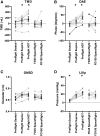Noninvasive indicators of intracranial pressure before, during, and after long-duration spaceflight
- PMID: 35861522
- PMCID: PMC9484990
- DOI: 10.1152/japplphysiol.00625.2021
Noninvasive indicators of intracranial pressure before, during, and after long-duration spaceflight
Abstract
Weightlessness induces a cephalad shift of blood and cerebrospinal fluid that may increase intracranial pressure (ICP) during spaceflight, whereas lower body negative pressure (LBNP) may provide an opportunity to caudally redistribute fluids and lower ICP. To investigate the effects of spaceflight and LBNP on noninvasive indicators of ICP (nICP), we studied 13 crewmembers before and after spaceflight in seated, supine, and 15° head-down tilt postures, and at ∼45 and ∼150 days of spaceflight with and without 25 mmHg LBNP. We used four techniques to quantify nICP: cerebral and cochlear fluid pressure (CCFP), otoacoustic emissions (OAE), ultrasound measures of optic nerve sheath diameter (ONSD), and ultrasound-based internal jugular vein pressure (IJVp). On flight day 45, two nICP measures were lower than preflight supine posture [CCFP: mean difference -98.5 -nL (CI: -190.8 to -6.1 -nL), P = 0.037]; [OAE: -19.7° (CI: -10.4° to -29.1°), P < 0.001], but not significantly different from preflight seated measures. Conversely, ONSD was not different than any preflight posture, whereas IJVp was significantly greater than preflight seated measures [14.3 mmHg (CI: 10.1 to 18.5 mmHg), P < 0.001], but not significantly different than preflight supine measures. During spaceflight, acute LBNP application did not cause a significant change in nICP indicators. These data suggest that during spaceflight, nICP is not elevated above values observed in the seated posture on Earth. Invasive measures would be needed to provide absolute ICP values and more precise indications of ICP change during various phases of spaceflight.NEW & NOTEWORTHY The current study provides new evidence that intracranial pressure (ICP), as assessed with noninvasive measures, may not be elevated during long-duration spaceflight. In addition, the acute use of lower body negative pressure did not significantly reduce indicators of ICP during weightlessness.
Keywords: intracranial pressure; noninvasive intracranial pressure; spaceflight.
Conflict of interest statement
No conflicts of interest, financial or otherwise, are declared by the authors.
Figures





Similar articles
-
Lower-body negative pressure decreases noninvasively measured intracranial pressure and internal jugular vein cross-sectional area during head-down tilt.J Appl Physiol (1985). 2017 Jul 1;123(1):260-266. doi: 10.1152/japplphysiol.00091.2017. Epub 2017 May 11. J Appl Physiol (1985). 2017. PMID: 28495841 Free PMC article.
-
Lower body negative pressure reduces jugular and portal vein volumes and counteracts the elevation of middle cerebral vein velocity during long-duration spaceflight.J Appl Physiol (1985). 2021 Sep 1;131(3):1080-1087. doi: 10.1152/japplphysiol.00231.2021. Epub 2021 Jul 29. J Appl Physiol (1985). 2021. PMID: 34323592 Free PMC article.
-
Intraocular pressure and choroidal thickness respond differently to lower body negative pressure during spaceflight.J Appl Physiol (1985). 2021 Aug 1;131(2):613-620. doi: 10.1152/japplphysiol.01040.2020. Epub 2021 Jun 24. J Appl Physiol (1985). 2021. PMID: 34166098 Free PMC article.
-
Visual changes after space flight: is it really caused by increased intracranial tension? A systematic review.J Neurosurg Sci. 2020 Oct;64(5):468-479. doi: 10.23736/S0390-5616.20.04927-9. Epub 2020 Apr 29. J Neurosurg Sci. 2020. PMID: 32347675
-
Non-Invasive Intracranial Pressure Monitoring and Its Applicability in Spaceflight.Aerosp Med Hum Perform. 2022 Jun 1;93(6):517-531. doi: 10.3357/AMHP.5922.2022. Aerosp Med Hum Perform. 2022. PMID: 35729760 Review.
Cited by
-
Ocular perfusion pressure is not reduced in response to lower body negative pressure.NPJ Microgravity. 2024 Jun 8;10(1):67. doi: 10.1038/s41526-024-00404-5. NPJ Microgravity. 2024. PMID: 38851800 Free PMC article.
-
Otoacoustic Estimate of Astronauts' Intracranial Pressure Changes During Spaceflight.J Assoc Res Otolaryngol. 2024 Dec;25(6):563-573. doi: 10.1007/s10162-024-00962-1. Epub 2024 Sep 13. J Assoc Res Otolaryngol. 2024. PMID: 39271581 Free PMC article.
-
Optimizing healthcare in space: the role of ultrasound imaging in medical conditions.J Ultrasound. 2024 Dec;27(4):793-811. doi: 10.1007/s40477-024-00930-8. Epub 2024 Jul 12. J Ultrasound. 2024. PMID: 38995615
-
Ocular Deformations in Spaceflight-Associated Neuro-Ocular Syndrome and Idiopathic Intracranial Hypertension.Invest Ophthalmol Vis Sci. 2023 Mar 1;64(3):32. doi: 10.1167/iovs.64.3.32. Invest Ophthalmol Vis Sci. 2023. PMID: 36988950 Free PMC article.
-
Homo sapiens-A Species Not Designed for Space Flight: Health Risks in Low Earth Orbit and Beyond, Including Potential Risks When Traveling beyond the Geomagnetic Field of Earth.Life (Basel). 2023 Mar 10;13(3):757. doi: 10.3390/life13030757. Life (Basel). 2023. PMID: 36983912 Free PMC article. Review.
References
-
- Mader TH, Gibson CR, Pass AF, Kramer LA, Lee AG, Fogarty J, Tarver WJ, Dervay JP, Hamilton DR, Sargsyan A, Phillips JL, Tran D, Lipsky W, Choi J, Stern C, Kuyumjian R, Polk JD. Optic disc edema, globe flattening, choroidal folds, and hyperopic shifts observed in astronauts after long-duration space flight. Ophthalmology 118: 2058–2069, 2011. doi:10.1016/j.ophtha.2011.06.021. - DOI - PubMed
-
- Marshall-Bowman K, Barratt MR, Gibson CR. Ophthalmic changes and increased intracranial pressure associated with long duration spaceflight: an emerging understanding. Acta Astronaut 87: 77–87, 2013. doi:10.1016/j.actaastro.2013.01.014. - DOI
-
- Macias BR, Patel NB, Gibson CR, Samuels BC, Laurie SS, Otto C, Ferguson CR, Lee SMC, Ploutz-Snyder R, Kramer LA, Mader TH, Brunstetter T, Stenger MB. Association of long-duration spaceflight with anterior and posterior ocular structure changes in astronauts and their recovery. JAMA Ophthalmol 138: 553–559, 2020. doi:10.1001/jamaophthalmol.2020.0673. - DOI - PMC - PubMed
Publication types
MeSH terms
Grants and funding
LinkOut - more resources
Full Text Sources

